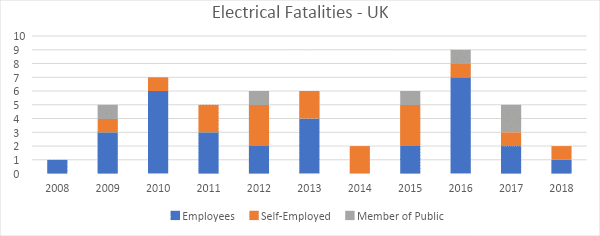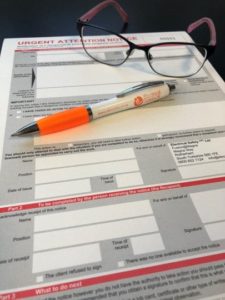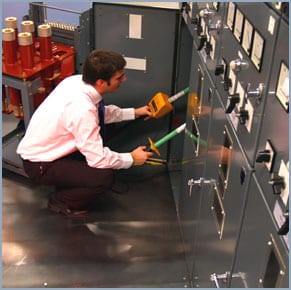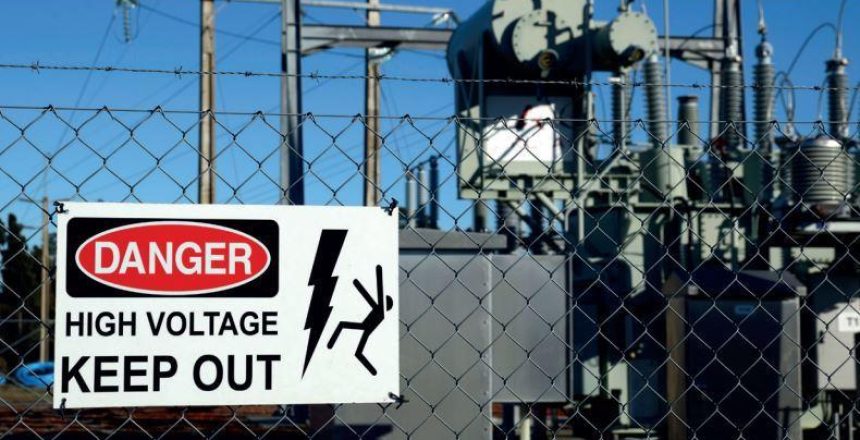Correctly speaking, electricity is a hazard, as it has the potential to cause harm, but if properly managed, the likelihood of harm being caused is minimal. Although, the severity of electrical hazards (sometimes referred to as consequence) when things go wrong will potentially be fatal or life changing.
For those who take frequency into account in risk assessment, the Health and Safety Executive tell us that fatality through electric shock is a low frequency event, although just one life taken is too many.

Dangers of electricity
Regulation 2 of the Electricity at Work Regulations 1989 refers to the dangers associated with electricity as being ‘the risk of injury’. Electrical hazards may cause death or personal injury from:
- electric shock
- electric burn
- electrical explosion or arcing,
- fire or explosion initiated by electrical energy (where any such death or injury is associated with the generation, provision, transmission, transformation, rectification, conversion, conduction, distribution, control, storage, measurement or use of electrical energy’).
Incidents do happen and the Electricity at Work Regulations 1989 applies to all work activity in such proximity to electrical systems where danger might be present. Therefore, the extent of the law is not restricted to electricians and electrical engineers, but applies equally to mechanical engineers, construction workers, production staff and office employees alike, where their work activity might expose them to the dangers of electricity.
Examples of electrical hazard risks include:
- Electric shock and burns from live wire contact
- Fires from faulty wiring
- Overloading circuits
- Leaving electrical parts exposed
- Electrocution or burns from lack of PPE
- Explosions and fires from explosive and flammable substances.
- Contact with overhead power lines
- Electrical exposure to water
If electricity is so dangerous, why are there so few fatalities?
Good question! There is certainly a level of underreporting electrical incidents taking place. Many people will recount experiences of near-misses when it comes to electricity. 2 main hazards of electricity include electric shock or arc flash (flash over). In other instances, the root cause is not correctly identified, and electrical energy is not recognised as initiating a serious outcome. But in reality, the very low frequency of fatality through contact with electricity can be put down to good electrical safety management systems. The UK has robust electrical standards, many of which are non-statutory, but all the same they are aggressively enforced.
This is a good situation to be in but it can breed complacency. As electrical hazard standards have improved over the years, and the level of safety offered reduces incidence levels, people become complacent and companies look towards electrical management as being an area for saving costs- this puts us all in a precarious situation.

How to prevent electrical hazard accidents
So how do we keep people safe? – Safe Systems, Safe People and Safe Places are the answer! Safe Systems refers to safe systems of work, and starts with the recognition of those who have specific responsibilities with regards to electricity. This is often referred to as the Duty Holder structure, with the level of organisation being dependent on the size of a company and the work that it undertakes. This is required by Regulation 4(3) of the Electricity at Work Regulations 1989.

Those responsible for managing electrical safety will need some form of regulation, again, relevant to the business and its undertaking. Electrical Safety Rules will be a requirement for many companies which should be accompanied by supporting procedures to ensure that those who have to follow the rules have sufficient information to do so safely. Certain work activities will be managed by safety documents, such as electrical Permit to Work, Sanction for Test or Limitation of Access, all of which should be in place if needed.
Take electrical risk assessments
Risk assessment is also an essential part of safe systems of work, as are method statements and standard operating practices. For those working on high energy systems, be it at high voltage or low voltage, the risk of arc flash and arc blast is a serious matter, and should be assessed accordingly. Working inside electrical panels should also be carefully assessed, as should any works that have an element of live working. Remember, any equipment provided to keep people safe must comply with Regulation 4(4) of the Electricity at Work Regulations 1989.
At this time, we’re offering free electrical safety health checks with a full report.
Alternatively, you can take a 17 question electrical self assessment here.

Train safe workers
Safe People relates to only competent persons undertaking works on or near to electrical systems. They are persons who have the knowledge and experience to undertake work and having the ability to recognise electrical danger. Although knowledge and experience are the tests set by Regulation 16 of the Electricity at Work Regulations 1989, skill, knowledge, attitude, training and experience should be considering factors when considering the competence of an individual. Remember, competence is relevant to the work that is being undertaken. Not all persons are created equal, and the temptation to assume that an electrician is competent to undertake every work task can land employers in trouble when things go wrong.
Therefore, a well-documented competency assessment system and formal appointment of persons to undertake clearly defined roles is strongly recommended. Remember, training certificates are only a part of this process, and any training provided to employees must be relevant to the work that they undertake.
All of this good work aims to prevent a contravention of Regulation 16 of the Electricity at Work Regulations 1989. Supervision also plays an important role in keeping everyone safe, but is often overlooked or is mistaken with good contract management and meeting tight financial and time-bound deadlines.
Good electrical safety management
Safe Places starts with electrical systems that have been correctly designed, this includes systems that have been inherited and are aged. Regulation 4(1) of the Electricity at Work Regulations 1989 specifically requires that ‘all systems shall at all times be of such construction as to prevent, so far as is reasonably practicable, danger’. Naturally, electrical systems should be correctly constructed in accordance with the design requirements by competent persons who are following the safe systems of work. Such systems should be operated correctly so as to avoid electrical hazards.

If electrical systems and equipment have the potential to deteriorate and introduce danger, Regulation 4(2) of the Electricity at Work Regulations 1989 requires maintenance to be carried out. The maintenance should be sufficient to avoid danger arising, and the frequency of such maintenance should be determined by the Duty Holder, taking into account relevant information, such as industry guidance, historic data, and the results of auditing.
Remember, the Health and Safety Executive recognise that inspection and testing is a recognised method of determining the effectiveness of maintenance programmes, but accepts that other systems, such as robust planned preventative maintenance may be a suitable alternative to inspection and testing in some instances.
Electrical Safety Management will be different for each employer, whilst some models might cover most aspects of a company’s requirements, it may not be a perfect fit. We strongly advise that, in most cases, such systems are bespoke to align both with the business undertaking service offering and the management and staff structure that is in place.
For further information on electrical safety management, for support in undertaking electrical system studies, and for help and advice on competency assessment and training, Electrical Safety UK have the skill and resources to put you in a compliant position, having opportunities to help you become more financially viable and potential for business expansion. Give us a call today, and get peace of mind with regards to the ‘hazards of electricity’.





